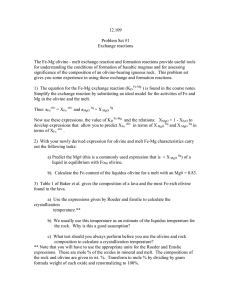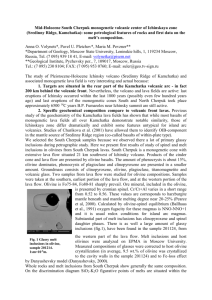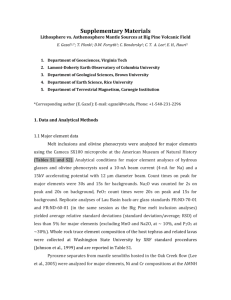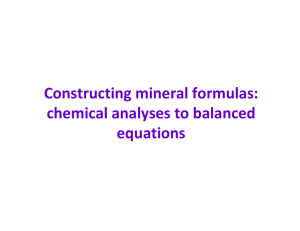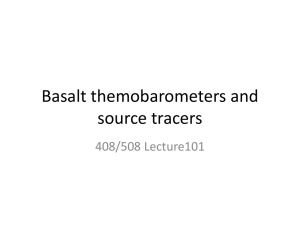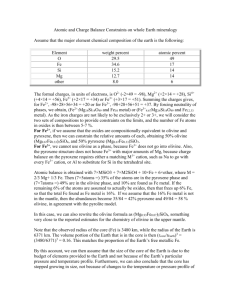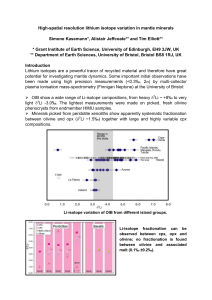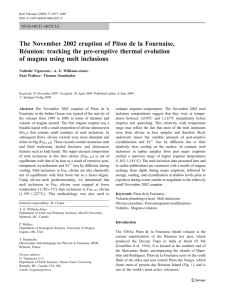Variability of Mauna Loa melt inclusions P. Armienti and D. Gasperini
advertisement
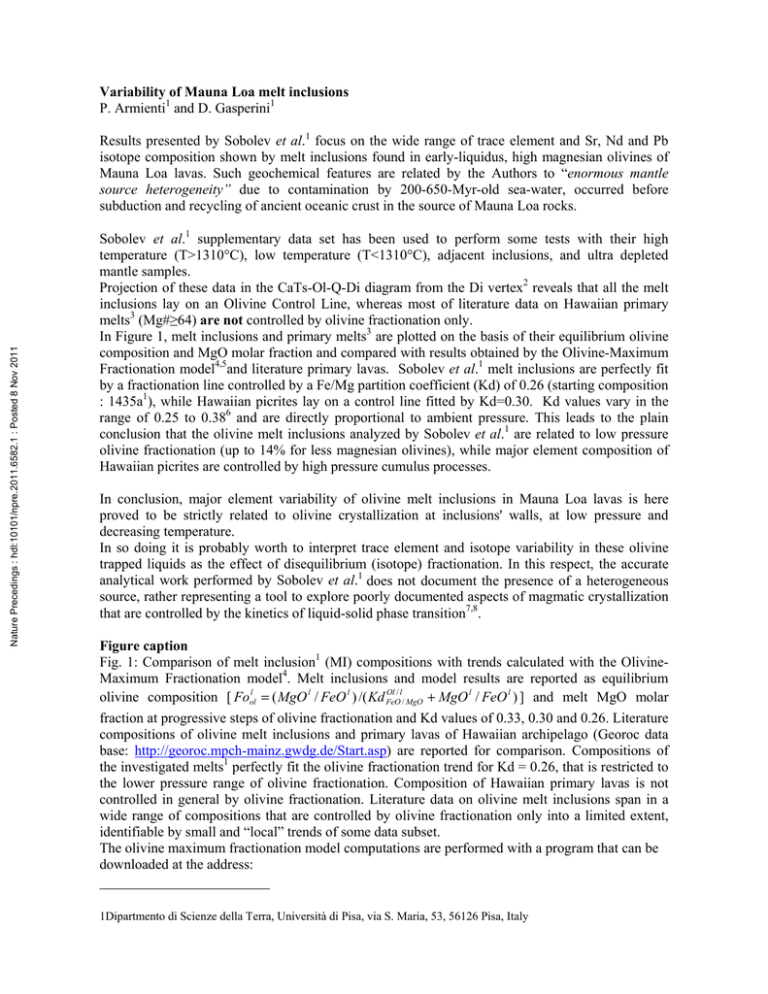
Variability of Mauna Loa melt inclusions P. Armienti1 and D. Gasperini1 Nature Precedings : hdl:10101/npre.2011.6582.1 : Posted 8 Nov 2011 Results presented by Sobolev et al.1 focus on the wide range of trace element and Sr, Nd and Pb isotope composition shown by melt inclusions found in early-liquidus, high magnesian olivines of Mauna Loa lavas. Such geochemical features are related by the Authors to “enormous mantle source heterogeneity” due to contamination by 200-650-Myr-old sea-water, occurred before subduction and recycling of ancient oceanic crust in the source of Mauna Loa rocks. Sobolev et al.1 supplementary data set has been used to perform some tests with their high temperature (T>1310°C), low temperature (T<1310°C), adjacent inclusions, and ultra depleted mantle samples. Projection of these data in the CaTs-Ol-Q-Di diagram from the Di vertex2 reveals that all the melt inclusions lay on an Olivine Control Line, whereas most of literature data on Hawaiian primary melts3 (Mg#≥64) are not controlled by olivine fractionation only. In Figure 1, melt inclusions and primary melts3 are plotted on the basis of their equilibrium olivine composition and MgO molar fraction and compared with results obtained by the Olivine-Maximum Fractionation model4,5and literature primary lavas. Sobolev et al.1 melt inclusions are perfectly fit by a fractionation line controlled by a Fe/Mg partition coefficient (Kd) of 0.26 (starting composition : 1435a1), while Hawaiian picrites lay on a control line fitted by Kd=0.30. Kd values vary in the range of 0.25 to 0.386 and are directly proportional to ambient pressure. This leads to the plain conclusion that the olivine melt inclusions analyzed by Sobolev et al.1 are related to low pressure olivine fractionation (up to 14% for less magnesian olivines), while major element composition of Hawaiian picrites are controlled by high pressure cumulus processes. In conclusion, major element variability of olivine melt inclusions in Mauna Loa lavas is here proved to be strictly related to olivine crystallization at inclusions' walls, at low pressure and decreasing temperature. In so doing it is probably worth to interpret trace element and isotope variability in these olivine trapped liquids as the effect of disequilibrium (isotope) fractionation. In this respect, the accurate analytical work performed by Sobolev et al.1 does not document the presence of a heterogeneous source, rather representing a tool to explore poorly documented aspects of magmatic crystallization that are controlled by the kinetics of liquid-solid phase transition7,8. Figure caption Fig. 1: Comparison of melt inclusion1 (MI) compositions with trends calculated with the OlivineMaximum Fractionation model4. Melt inclusions and model results are reported as equilibrium Ol / l l l olivine composition [ Fooll = ( MgO l / FeO l ) /( Kd FeO / MgO + MgO / FeO ) ] and melt MgO molar fraction at progressive steps of olivine fractionation and Kd values of 0.33, 0.30 and 0.26. Literature compositions of olivine melt inclusions and primary lavas of Hawaiian archipelago (Georoc data base: http://georoc.mpch-mainz.gwdg.de/Start.asp) are reported for comparison. Compositions of the investigated melts1 perfectly fit the olivine fractionation trend for Kd = 0.26, that is restricted to the lower pressure range of olivine fractionation. Composition of Hawaiian primary lavas is not controlled in general by olivine fractionation. Literature data on olivine melt inclusions span in a wide range of compositions that are controlled by olivine fractionation only into a limited extent, identifiable by small and “local” trends of some data subset. The olivine maximum fractionation model computations are performed with a program that can be downloaded at the address: 1Dipartmento di Scienze della Terra, Università di Pisa, via S. Maria, 53, 56126 Pisa, Italy http://www.dst.unipi.it/claroline185/claroline/backends/download.php?url=L29sX21heF9mcl9tb2R lbC54bHM%3D&cidReset=true&cidReq=SFTETNA Nature Precedings : hdl:10101/npre.2011.6582.1 : Posted 8 Nov 2011 References: 1. Sobolev, A. V., Hofmann, A. W., Jochum, K. P., Kuzmin, D. V & Stoll, B. A young source for the Hawaiian plume. Nature 476, doi: 10.1038/nature10321 (2011) 2. Armienti, P. & Longo, P. Three-dimensional representation of geochemical data from a multidimensional compositional space. Int. J. Geosc. 2, 231-239 (2011). 3. Armienti, P., & Gasperini, D. Do We Really Need Mantle Components to Define Mantle Composition? J. Petrol. 48, 693-809 (2007). 4. Pearce, T. H. Olivine fractionation equations for basaltic and ultrabasic rocks. Nature 276, 771774 (1978). 5. Armienti, P., Gasperini, D., Perinelli, C. & Putirka, K. D. A new model for estimating deep-level magma ascent rates from thermobarometry: an example from Mt. Etna, and implications for deepseated magma dehydration. Acta Vulcan. 21, 145-158 (2009). 6. Ford, C. E., Russel D. G., Craven, J. A. & Fisk, M. R. Olivine-Liquid equilibria: temperature, pressure and composition dependence of the crystal/liquid cation partition coefficients for Mg, Fe2+, Ca and Mn. J. Petrol. 24 (3), 256-266 (1983). 7. Watson, E. B. & Müller, T. Non-equilibrium isotopic and elemental fractionation during diffusion-controlled crystal growth under static and dynamic conditions. Chem. Geol. 267, 111-124 (2009). 8. Spandler, C., O’Neill H. St. C. & Kamenetsky. Survival times of anomalous melt inclusions from element diffusion in olivine and chromite. Nature 447, doi: 10.1038/nature05759 (2007). Nature Precedings : hdl:10101/npre.2011.6582.1 : Posted 8 Nov 2011
